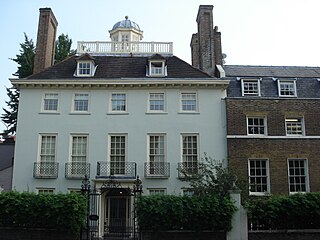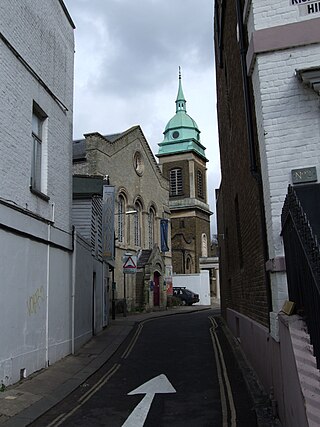
Richmond Green is a recreation area near the centre of Richmond, a town of about 20,000 inhabitants situated in south-west London. Owned by the Crown Estate, it is leased to the London Borough of Richmond upon Thames. The Green, which has been described as "one of the most beautiful urban greens surviving anywhere in England", is roughly square in shape and its open grassland, framed with broadleaf trees, extends to roughly twelve acres. On the north-east side there is also a smaller open space called Little Green. Richmond Green and Little Green are overlooked by a mixture of period townhouses, historic buildings and municipal and commercial establishments including the Richmond Lending Library and Richmond Theatre.

Seaford House, originally called Sefton House, is a former aristocratic mansion and the largest of the detached houses sited on each corner of Belgrave Square, London, England. It is a magnolia stucco building with four main storeys most famed for its interiors.

Dulwich Park is a 30.85-hectare (76.2-acre) public park in Dulwich in the London Borough of Southwark, south London, England. The park was created by the Metropolitan Board of Works from former farmland and meadows. While the initial design was by Charles Barry (junior), it was later refined by Lt Col JJ Sexby. It was opened in 1890 by Lord Rosebery. From 2004 to 2006, the park was restored to its original Victorian layout, following a grant from the Heritage Lottery Fund. The park is listed Grade II on the Register of Historic Parks and Gardens.

Bath and North East Somerset is a unitary authority created on 1 April 1996, following the abolition of the County of Avon, which had existed since 1974. Part of the ceremonial county of Somerset, Bath and North East Somerset occupies an area of 220 square miles (570 km2), two-thirds of which is green belt. It stretches from the outskirts of Bristol, south into the Mendip Hills and east to the southern Cotswold Hills and Wiltshire border. The city of Bath is the principal settlement in the district, but BANES also covers Keynsham, Midsomer Norton, Radstock and the Chew Valley. The area has a population of 170,000, about half of whom live in Bath, making it 12 times more densely populated than the rest of the area.

Claremont Square is a square in the Angel (Pentonville) part of Islington, London. Its central green mound, hiding a reservoir, is dotted with mature trees on all four sides (embankments). On its north side is Pentonville Road. It is lined on the south, east and west sides by early-nineteenth-century houses, and on the north side, across the arterial road, by heavily recessed apartment/office buildings. Many of the houses have been internally subdivided.

Devonshire House is an 18th-century house at 44 Vicarage Crescent, Battersea, London. It is a listed Grade II* on the National Heritage List for England along with its iron gate and railings. The interior of the house contains its original paneling.

Ossulston House is a Grade II listed building opposite Joslin's Pond in Hadley Green Road, Hadley, to the north of Chipping Barnet. It is one of what was an almost complete line of houses between Chipping Barnet and Monken Hadley along the east side of Hadley Green which were built in the 18th and 19th centuries as wealthy merchants from London populated the area.

Hadley Hurst is a grade II* listed building on Hadley Common road, in Monken Hadley, north of Chipping Barnet.

Grandon is a grade II listed building on Hadley Green Road, in Monken Hadley, north of Chipping Barnet. The house faces Hadley Green and was once the home of the writers Fanny Trollope and her son Anthony Trollope.

Hadley House is a grade II* listed building on Hadley Green Road facing Hadley Green. The house dates from 1760. The stable block and garden wall are also listed.

The Gate House and Gate, Monken Hadley, in the London Borough of Barnet, are grade II listed buildings The house is in the Gothic style, early nineteenth century. The gates are of timber and are one of a number of white timber gates that mark the main access points to Monken Hadley Common.

Pagitts Almshouses, 1–6 Hadley Green Road, Monken Hadley, in the London Borough of Barnet, are grade II listed buildings. The almshouses are on the north side of the road between St Mary, Monken Hadley church and the Monken Hadley Common Gate House and Gates.

Pymlicoe House is a grade II listed house in Hadley Green West, Monken Hadley, in the London Borough of Barnet. The house dates from the later 18th century and was probably stuccoed in the mid 19th century.

White Lodge is a grade II listed building on Hadley Green Road in Monken Hadley. The original house was built before 1711, and extended in the late 18th century.

The Vineyard is a street in Richmond, in the London Borough of Richmond upon Thames. It includes three groups of almshouses, a Grade II listed church and Clarence House, a 17th-century Grade II listed house associated with Bernardo O’Higgins, who is commemorated on the wall of the property with a blue plaque, installed by English Heritage, for his role in the Chilean War of Independence.

Hadley is a district of the London Borough of Barnet between Chipping Barnet in the south and Monken Hadley in the north. It was formerly a civil parish of Barnet Urban District.

As of February 2001, there were 1,124 listed buildings with Grade II status in the English city of Brighton and Hove. The total at 2009 was similar. The city, on the English Channel coast approximately 52 miles (84 km) south of London, was formed as a unitary authority in 1997 by the merger of the neighbouring towns of Brighton and Hove. Queen Elizabeth II granted city status in 2000.
As of February 2001, there were 1,124 listed buildings with Grade II status in the English city of Brighton and Hove. The total at 2009 was similar. The city, on the English Channel coast approximately 52 miles (84 km) south of London, was formed as a unitary authority in 1997 by the merger of the neighbouring towns of Brighton and Hove. Queen Elizabeth II granted city status in 2000.

Church Row is a residential street in Hampstead in the London Borough of Camden. Many of the properties are listed on the National Heritage List for England. The street runs from Frognal in the west to Heath Street in the east. St John-at-Hampstead and its additional burial ground is at the west end of the street.


















